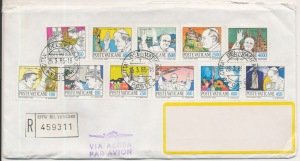Special Event or Commemorative covers are an envelope, with an artistic cachet, canceled with a stamp that honors and event or special occurrence. Special Event covers have been in the philatelic news lately as they have been issued quickly to honor the investiture of the new Pope. Special Event covers exist for Papal inaugurations, Presidential inaugurations, Royal Weddings, births-in fact anyone can design an envelope for anything, add a stamp and you have a Special Event Cover.
Covers of this type have a long and varied history. The idea of a design on a cover, either germane to the subject at hand or allegorical, goes back to the first stamp issue-the Mulready envelopes which Rowland Hill had devised to compete with the Penny Black in 1840, and which never really caught on. Throughout the nineteenth century covers were used with designs on them to make political or business points. This was most common in the United States where during the Civil War hundreds of “Patriotics” were used as envelopes. These covers were among the first Special Events and were used as morale boosters and to prove one’s Union bona fides. The latter nineteenth century brought a peculiar American variation on the illustrated envelope-the advertising envelope which, while not strictly a Special Event cover, sensitized collectors to the concept. (Advertising covers are envelopes sent by business in which the return address morphed into an ornate illustrated design displaying the wares or services that the company offered. Advertising covers were largely an American phenomenon and have a link to the exceptionalism and egotism that are part of the nineteenth century American commercial character).
By the early twentieth century, the idea that designs on envelopes could be part of the postal and commemorative message of a cover had become part of the hobby. First Day Cover cachets furthered this association and by the 1920s the first Special Event covers were born. The earliest Special Event covers centered around four main things-Presidential inaugurations, Airmail flights and airport dedications, Naval dedications, and Zeppelin related material. The 1930s produced millions of Special Event covers (and though covers of these types exist from around the world, this was largely an American phenomenon) and, along with First day Covers, this produced an entire generation of collectors who would have identified themselves as primarily cover collectors. The fact that Special Event covers have no government sanction served as the demise of this specialty. Anyone could make covers of this type and for a while everyone did. One of the lures of philately is that, despite its vastness, each collecting area is finite. When anyone can issue collectible items, the game losses its appeal. By 1980 so many companies were preparing overpriced commemorative covers for so many different events that collectors by and large lost interest.
The installation of Pope Francis will prompt a plethora of Special Event covers commemorating every event in his life from his baptism on. In the past, covers of this type have sold well for each of the Popes who have had Papal covers issued (and they began with Pope Pius). Their resale in later markets, though, has not been so good. Each Pope in the last sixty years has been marketed philatelically as a ground breaking pope-the first Pole, the People’s Pope, and now the first Latin American Pope. And if you have a particular fondness for this Pope by all means buy the covers that are being sold. Keep in mind, however, that millions of covers will be sold and the resale value of nearly all Papal philatelic material since Pope Pius XII was installed in 1939 is essentially nil.

